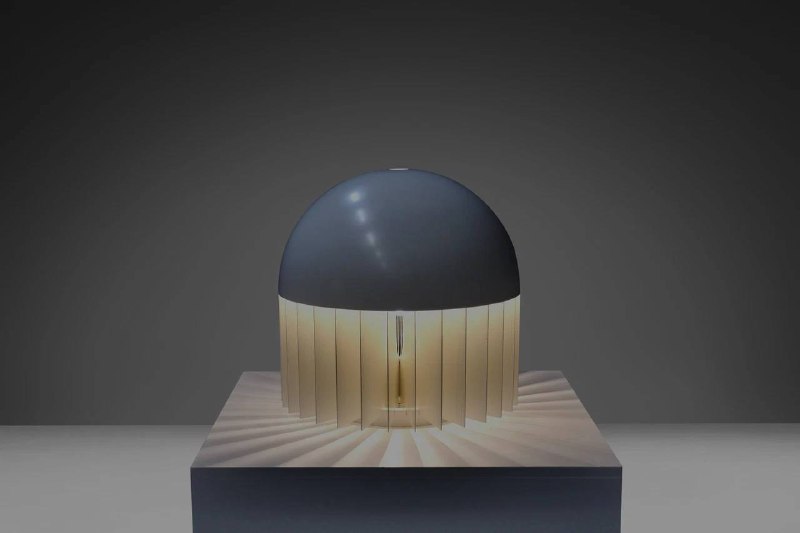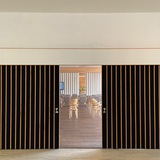Упомянутый нами Джанкарло Маттиоли (1933-2018) начинал как художник-график, а став дипломированным архитектором, в 1961 г. основал архитектурный коллектив «Città Nuova». Со своими коллегами по этому объединению он и принял участие в конкурсе, в 1965 г. организованном компанией «Artemide» и журналом «Domus» в целях поиска новых форм для светильников, и занял в этом конкурсе первое место, предложив настольную лампу «Nesso», которая пополнила собой постоянные экспозиции ведущих музеев дизайна по всему миру.
Хоть с конца 1960-х гг. Маттиоли занимался градостроительными проектами в своем родном городе, Болонье, он оставил после себя еще как минимум одну лампу. Слегка похожая на медузу, как и ее предшественница «Nesso», эта лампа, выпущенная в 1969 г. под названием «MT», имела ряд существенных отличий. Во-первых, она изготавливалсь из алюминия, а не пластика, во-вторых, источник света не был полностью скрыт от глаз, а в-третьих, свет рассеивался не диффузно, а радиально, создавая геометрический рисунок на поверхности. Кроме того, лампа «MT» была достаточно крупной и могла использоваться в качестве как настольного, так и напольного светильника.
———
Italian architect and designer Giancarlo Mattioli (1933–2018) began his career as a pen artist and, after graduating as an architect, founded a group of urban architects called Città Nuova in 1961. It was with his colleagues of Città Nuova that Mattioli took part in a 1965 contest hosted by Artemide and the Domus magazine to explore new lighting design possibilities, winning the competition with his Nesso table lamp that would become one of the 20th century design icons featured in major museums of modern art and design.
Although from the late 1960s onwards, Mattioli mostly focused on urban planning projects in his hometown of Bologna, he did produce at least one important lamp. Somewhat resembling its jellyfish-like predecessor, Nesso, this lamp released as MT in 1969 was at the same time distinctly different: unlike the plastic Nesso, it was made of aluminum, the bulb was not fully concealed under the shade, and, thanks to multiple fins, the light was diffused radially, creating geometric patterns on surfaces. Additionally, the MT lamp was larger, enabling it to function as either a table lamp or a floor lamp.
(photos: artemide.com, quittenbaum.de, paulbert-serpette.com, whoppah.com, fundamente.nl)
Хоть с конца 1960-х гг. Маттиоли занимался градостроительными проектами в своем родном городе, Болонье, он оставил после себя еще как минимум одну лампу. Слегка похожая на медузу, как и ее предшественница «Nesso», эта лампа, выпущенная в 1969 г. под названием «MT», имела ряд существенных отличий. Во-первых, она изготавливалсь из алюминия, а не пластика, во-вторых, источник света не был полностью скрыт от глаз, а в-третьих, свет рассеивался не диффузно, а радиально, создавая геометрический рисунок на поверхности. Кроме того, лампа «MT» была достаточно крупной и могла использоваться в качестве как настольного, так и напольного светильника.
———
Italian architect and designer Giancarlo Mattioli (1933–2018) began his career as a pen artist and, after graduating as an architect, founded a group of urban architects called Città Nuova in 1961. It was with his colleagues of Città Nuova that Mattioli took part in a 1965 contest hosted by Artemide and the Domus magazine to explore new lighting design possibilities, winning the competition with his Nesso table lamp that would become one of the 20th century design icons featured in major museums of modern art and design.
Although from the late 1960s onwards, Mattioli mostly focused on urban planning projects in his hometown of Bologna, he did produce at least one important lamp. Somewhat resembling its jellyfish-like predecessor, Nesso, this lamp released as MT in 1969 was at the same time distinctly different: unlike the plastic Nesso, it was made of aluminum, the bulb was not fully concealed under the shade, and, thanks to multiple fins, the light was diffused radially, creating geometric patterns on surfaces. Additionally, the MT lamp was larger, enabling it to function as either a table lamp or a floor lamp.
(photos: artemide.com, quittenbaum.de, paulbert-serpette.com, whoppah.com, fundamente.nl)
2❤41👍9🔥3
group-telegram.com/midcenturymodern/18478
Create:
Last Update:
Last Update:
Упомянутый нами Джанкарло Маттиоли (1933-2018) начинал как художник-график, а став дипломированным архитектором, в 1961 г. основал архитектурный коллектив «Città Nuova». Со своими коллегами по этому объединению он и принял участие в конкурсе, в 1965 г. организованном компанией «Artemide» и журналом «Domus» в целях поиска новых форм для светильников, и занял в этом конкурсе первое место, предложив настольную лампу «Nesso», которая пополнила собой постоянные экспозиции ведущих музеев дизайна по всему миру.
Хоть с конца 1960-х гг. Маттиоли занимался градостроительными проектами в своем родном городе, Болонье, он оставил после себя еще как минимум одну лампу. Слегка похожая на медузу, как и ее предшественница «Nesso», эта лампа, выпущенная в 1969 г. под названием «MT», имела ряд существенных отличий. Во-первых, она изготавливалсь из алюминия, а не пластика, во-вторых, источник света не был полностью скрыт от глаз, а в-третьих, свет рассеивался не диффузно, а радиально, создавая геометрический рисунок на поверхности. Кроме того, лампа «MT» была достаточно крупной и могла использоваться в качестве как настольного, так и напольного светильника.
———
Italian architect and designer Giancarlo Mattioli (1933–2018) began his career as a pen artist and, after graduating as an architect, founded a group of urban architects called Città Nuova in 1961. It was with his colleagues of Città Nuova that Mattioli took part in a 1965 contest hosted by Artemide and the Domus magazine to explore new lighting design possibilities, winning the competition with his Nesso table lamp that would become one of the 20th century design icons featured in major museums of modern art and design.
Although from the late 1960s onwards, Mattioli mostly focused on urban planning projects in his hometown of Bologna, he did produce at least one important lamp. Somewhat resembling its jellyfish-like predecessor, Nesso, this lamp released as MT in 1969 was at the same time distinctly different: unlike the plastic Nesso, it was made of aluminum, the bulb was not fully concealed under the shade, and, thanks to multiple fins, the light was diffused radially, creating geometric patterns on surfaces. Additionally, the MT lamp was larger, enabling it to function as either a table lamp or a floor lamp.
(photos: artemide.com, quittenbaum.de, paulbert-serpette.com, whoppah.com, fundamente.nl)
Хоть с конца 1960-х гг. Маттиоли занимался градостроительными проектами в своем родном городе, Болонье, он оставил после себя еще как минимум одну лампу. Слегка похожая на медузу, как и ее предшественница «Nesso», эта лампа, выпущенная в 1969 г. под названием «MT», имела ряд существенных отличий. Во-первых, она изготавливалсь из алюминия, а не пластика, во-вторых, источник света не был полностью скрыт от глаз, а в-третьих, свет рассеивался не диффузно, а радиально, создавая геометрический рисунок на поверхности. Кроме того, лампа «MT» была достаточно крупной и могла использоваться в качестве как настольного, так и напольного светильника.
———
Italian architect and designer Giancarlo Mattioli (1933–2018) began his career as a pen artist and, after graduating as an architect, founded a group of urban architects called Città Nuova in 1961. It was with his colleagues of Città Nuova that Mattioli took part in a 1965 contest hosted by Artemide and the Domus magazine to explore new lighting design possibilities, winning the competition with his Nesso table lamp that would become one of the 20th century design icons featured in major museums of modern art and design.
Although from the late 1960s onwards, Mattioli mostly focused on urban planning projects in his hometown of Bologna, he did produce at least one important lamp. Somewhat resembling its jellyfish-like predecessor, Nesso, this lamp released as MT in 1969 was at the same time distinctly different: unlike the plastic Nesso, it was made of aluminum, the bulb was not fully concealed under the shade, and, thanks to multiple fins, the light was diffused radially, creating geometric patterns on surfaces. Additionally, the MT lamp was larger, enabling it to function as either a table lamp or a floor lamp.
(photos: artemide.com, quittenbaum.de, paulbert-serpette.com, whoppah.com, fundamente.nl)
BY Mid-Century, More Than










Share with your friend now:
group-telegram.com/midcenturymodern/18478
